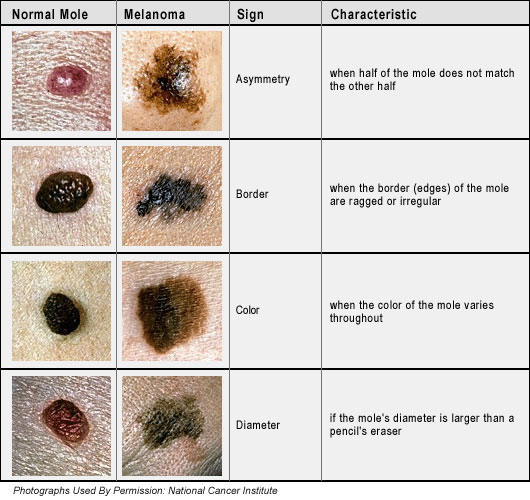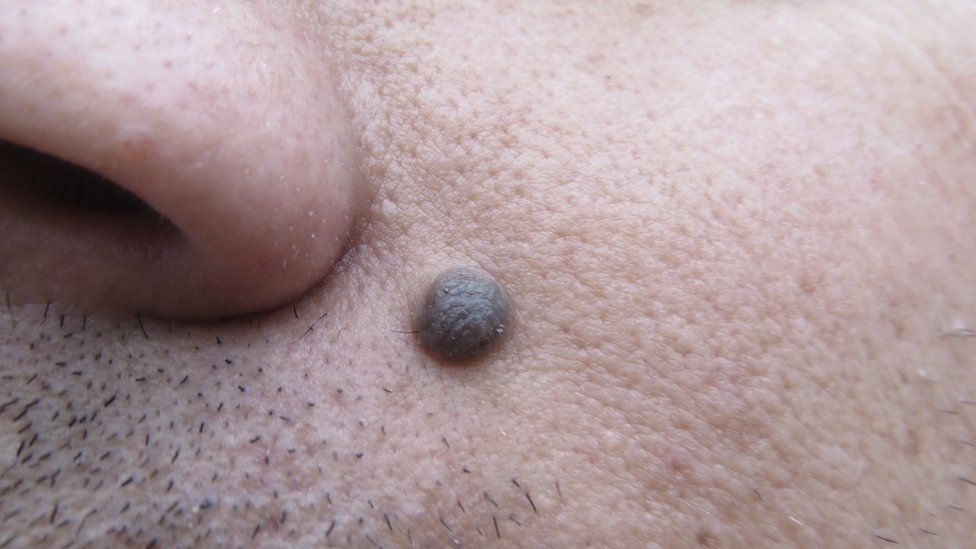Skin cancer types: Melanoma Signs and symptoms
Table Of Content

The risk of melanoma seems to be increasing in people under 40, especially women. Knowing the symptoms of skin cancer can help ensure that cancerous changes are detected and treated before the cancer has spread. Melanoma can be treated successfully if it is found early.
About Mayo Clinic
Most melanocytes are in the skin, and melanoma can occur on any skin surface. It can develop from a common mole or dysplastic nevus, but more often it develops in an area of apparently normal skin. In addition, melanoma can also develop in the eye (called uveal melanoma), under the nail, the digestive tract, and other areas of the body. A common mole is usually smaller than about 5 millimeters wide (about 1/4 inch, the width of a pencil eraser). It is round or oval, has a smooth surface with a distinct edge, and is often dome-shaped.
Appointments at Mayo Clinic
Depending on the type of mole, they’ll take a margin of healthy skin to ensure that all of the atypical cells are removed. Then, using forceps to grasp the segment, they lift the mole away. Bleeding is normal, and your surgeon may apply pressure to the area or burn (cauterize) it to stop the bleeding before stitching the area back together. Whether you were born with a mole or it developed over time, you might not like how it looks or feels.
What to expect from your doctor
Use the time to look for new moles and examine existing moles for anything unusual. Talk to your healthcare provider about any concerning findings. Sometimes, you look at a mole and think, “That doesn’t look quite right.” Don’t ignore those suspicions. There’s a chance what you see may be a sign of melanoma, a dangerous form of skin cancer. CCCA and LPP fall under the umbrella of lymphocytic scarring alopecia.

Congenital melanocytic nevi are present at birth, any moles appearing after birth are melanocytic nevi. Dark skinned people generally have fewer moles than those with fair skin. Once you know what to look for when spotting a suspicious mole, it’s easier to keep track of any old and new growths you have on your body.
You can search by location, condition, and procedure to find the dermatologist that’s right for you. If you want to diminish a noticeable scar, know these 10 things before having laser treatment. Both the CDC and the FDA warn against treating this common childhood condition on your own with non-prescription treatments. This will help you get comfortable with the kinds of moles you have and allow you to identify something that is new or changing. With melanoma, early detection is key—melanoma caught at later stages can be deadly.
Potential baldness cure found as skin moles could be key to getting hair 'like a teen' - The Mirror
Potential baldness cure found as skin moles could be key to getting hair 'like a teen'.
Posted: Fri, 23 Jun 2023 07:00:00 GMT [source]
In cancer cells, the DNA changes give different instructions. The changes tell the cancer cells to make many more cells quickly. Cancer cells can keep living when healthy cells would die. In people with brown and Black skin, typical moles are more likely to be dark brown or black.

Both can be done in a healthcare provider's office with local anesthetic. While a new mole doesn't always mean skin cancer, it is a good idea to get it checked. A 2017 study in the Journal of the American Academy of Dermatology found 29% of melanomas arose from an existing mole, while 70% arose from a new mole.
Does Tweezing a Hairy Mole Cause Cancer? - The New York Times
Does Tweezing a Hairy Mole Cause Cancer?.
Posted: Mon, 06 Sep 2010 07:00:00 GMT [source]
A hairy mole occurs when a mole contains hair follicles and the hair pushes through the darker pigmentation. The presence of hair on a mole does not always indicate the health of the mole since the hair is growing from the hair follicle, not your mole. A mole, or nevus, is a common type of skin spot that is often a different color from the surrounding area. It is made of clusters of melanocytes, the pigment-producing cells responsible for skin color. A mole can be present at birth or develop later in life.
However, sometimes, a dermatologist (a doctor specializing in skin conditions) will order a biopsy just to be safe. Skin tags are small, harmless growths that hang like a tag from your skin. While they are not medically concerning, they sometimes get caught on clothing or become irritated from rubbing between skin.
Common moles, dysplastic nevi, and melanoma vary by size, color, shape, and surface texture. The table below summarizes some differences between moles and cancer. Also, melanoma is cancer, so it can spread to other parts of the body. Mole removal treats atypical moles anywhere on your face, neck, arms legs or torso. Your healthcare provider may recommend removal of an atypical mole so they can run a test (biopsy) to see if the growth is cancerous (malignant) or precancerous. In a mole removal procedure, your dermatologist shaves or cuts a mole to remove it from your skin.
Be sure to follow your healthcare provider’s instructions for mole removal aftercare, and reach out if you have any concerning symptoms. Before a mole removal procedure, your healthcare provider inspects your skin. They may take pictures of your moles to compare against at a later date. They may also use a tool called a dermoscope to get a closer look at the mole and determine how to best remove it. Some moles respond to changes in hormone levels, as may occur during pregnancy, adolescence, and older age.
They can also provide the treatment needed to remove a mole with the lowest risks of problems and scarring. If you choose to leave your mole in place, you can safely use most types of hair removal treatments. If you choose to have it removed, you’ll likely be left with a scar. If your skin moles itch, you need to see a dermatologist. Most skin moles appear in early childhood and during the first 20 years of life. It is normal for a person to have between 10 to 40 moles by adulthood.
This set of five jumbo hot rollers is convenient for home and travel alike, and great for longer hair. But if that won’t quite cut it, you can also choose from options with additional rollers. This set of 31 rollers—in five color-coded sizes—is ideal for beginners (and The Home Edit binge-watchers). Bangs—this curler duo is easy to clip on for easy volume in a flash. Use both at once, anchored on either side of your face.
Free to everyone, these materials teach young people about common skin conditions, which can prevent misunderstanding and bullying. The most powerful tool you have for catching skin cancer early is to do regular skin self-checks. For more than 150 years, Harper’s Bazaar has been the preeminent fashion and beauty resource for women at every age. Every story we publish has been thoroughly researched and vetted by our team of beauty editors and industry experts. Roll hair around these flexible rods, then shape as desired; they’ll stay put without pins or clips, then just as easily release when you’re ready to style. And with 10 small rollers and eight medium in this set, there are enough for most heads of hair.
Comments
Post a Comment